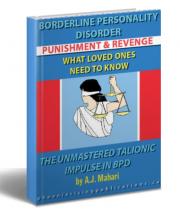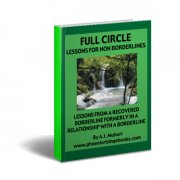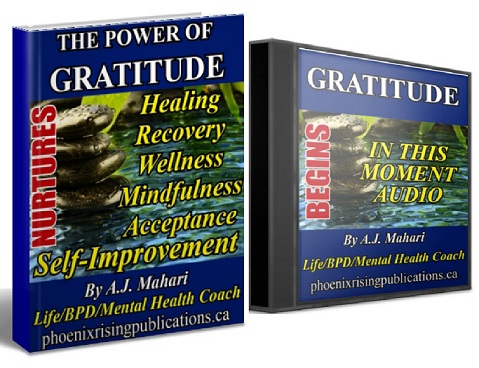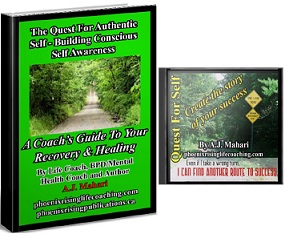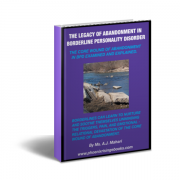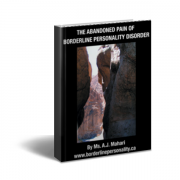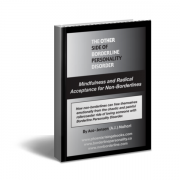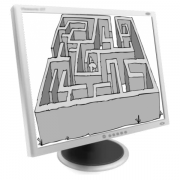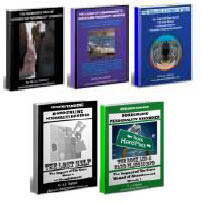![]()
Being Borderline: The Senseless Numbness of Agony
Borderlines numb their feelings to protect themselves from the very pain that they need to feel, grieve and move through in order to heal.
I refer to Borderline Personality Disorder as the Senseless Numbness of Agony because the very reason Borderlines are in such prolonged agony is a direct result of the continued choice made to numb the pain instead of finding healthy ways to release it. Borderlines numbing their pain are only increasing their pain each and very time they numb it. The stockpile of pain, anger, loss, isolation, and broken relationships only piles higher while the borderline, essentially, chooses to remain a victim and to stay stuck versus becoming a survivor and moving forward.
YES! It really is about choice.
It is easier, no matter how much it may hurt, or how much it may be costing you to continue to look back. You've been there hundreds of times before. You know what to expect. You know the patterns that wrap the landscape of your past. To heal from Borderline Personality Disorder you must learn to risk looking forward to what is intially scarey, unknown, untrusted, and very painfully anxiety-producing. The way out is through. You must FEEL in order to HEAL. You must HOPE in order to widen the lense of all that you SCOPE.
Recently a person with BPD wrote to me and said:
"I was wondering if you could write an article discussing emotional numbing as a defense mechanism and and how one can learn to feel feelings."
My sense is that emotional numbing is a way of coping; and that it becomes part of one's personality; but I am struggling with how to have emotional numbing be more permeable with ordinary ways of feeling feelings. I don't think it ever goes away, but I think the struggle is that of learning how to let both live together."
Emotional numbing, in my experience, and from what I've read from hundreds, if not, thousands of borderlines, is definitely a maladaptive coping mechanism designed to protect the borderline from feelings, yes. Even more that just this protection from feelings, however, numbing out is a maladaptive coping mechanism specifically intended to protect the borderline from the extemely angst-filled agonizing feelings that one can come to believe are powerful and strong enough to kill one.
Borderlines externalize their pain. Often this is the result of having suffered overwhelming pain during such early stages of emotional development that, quite literally, the only way one could possibly cope with what was happening to them was through the protective numbing externalization of the anger, neglect, abandonment, abuse etc. An infant or a young child has no place to put the wrath and abuse of others. It gets set aside. This practice of setting aside feelings that feel too big or too overwhelming to cope with or to fully understand then develops a life of its own.
I personally believe that when one sustains the kind of emotional wounds (as most borderlines do) that arrest emotional maturation or severely interrupt it, one is then unable to progress beyond certain maladaptive ways of coping. These maladaptive ways of coping, indeed, become ingrained patterns over time.
Herein lies a catch-22; the central dilemma of the borderline trying to cope with the numbness of his/her agony. The overwhelming feelings that are being numbed resulted from an inability to continue to mature and emotionally develop. (often caused by care-givers failure to nurture, abuse, and or neglect and abandonment - emotionally or physically). In order for a borderline to be able to get in touch with his/her feelings he/she must first begin to reclaim that numbed pain.
To reclaim numbed pain one must heal the wounds that led to it in the first place. In other words, each borderline must find a way back to their feelings at the time of his/her original wounds -- identify those feelings, FEEL those feelings, and then heal those wounds to facilitate growing beyond those emotionally- developmental blocks. It is only through this reclamation and growth that a borderline can hope to truly get in touch and stay in touch with his/her affect, emotions, mood, and feelings in any consistent and age-appropriate way.
Emotional numbing as a way of coping does not, in essence, become a part of one's personality -- rather it is (I believe) a central causative factor in the formation of a Borderline Personality Disorder. One's "true" personality lies damaged underneathe the presenting personality which is filtered through the disorder.
I do not think that one can effectively have both the patterns of numbing one's feelings and feeling one's feelings co-existing. I think that as one begins to learn how to get in touch with his or her feelings old patterns can and will over-lap the formation of new coping skills dealing with one's emotions, initially. Clearly, from my experience,in healing from BPD, however, there comes a point in knowledge and feeling when one must make a choice to FEEL over the choice to NUMB. This choice must be made countless times until being in touch with one's feelings as they occur becomes more natural than numbing one's feelings as they occur.
In as much as I do not think both, numbing and being in touch with one's feelings can live together there is a process in how to get from numbing to feeling. One cannot just jump from one to the other as that would be far too overwhelming and difficult to impossible to deal with.
How Do I Stop Numbing My Feelings?
The way to stop numbing your feelings and to learn to feel them involves first finding your personal safety. Personal safety is that intangible feeling that we are okay even when we hurt or are scared or threatened by some thing, feeling or thought, in the here and now and or from the past.
Personal safety allows us to hold some constant sense of security even when our over-all security is questionable due to flashbacks, triggers and dissociative experiences.
The way to develop this safety can be complex. It involves learning limits and boundaries which can truly only be established when you know more about who you are. So the question of identity must be addressed at this point (to some degree) as well.
Limits and boundaries are the healthy ways to protect ourselves that allow us to meet our own needs. I learned (the hard way -- believe me) in my recovery that we all need limits before we can feel safe. I was able to learn this and to develop this personal safety when I was in a group therapy program where for the first time in my life I was validated "enough" so as to be able to begin to trust my own feelings and instincts. The same feelings and instincts I had numbed for years and years because in my past in my dysfunctional family I was constantly told that whatever I felt and thought was "stupid", "silly", "nonsense" and so on. So, based upon my own experience it is vital when trying to get beyond numbing that one be working with a trusted and competent therapist.
In order to move from numbing to feeling you MUST WANT TO GO THERE. It is a CHOICE that each borderline must make. Yes getting better really has a lot to do with making the choice to do just that.
I get yelled at by borderlines for saying this but truly it was I know based upon having made the choice and having gotten better.
It takes more effort and more energy to hold on to all that is dysfunctional and toxic then it actually does to wade in to the grief and over time let go. In order to make the choice to heal the pain of holding on must outweigh your pain and fear of letting go. For each of us this day or time in our lives comes at different points according to the way in which we perceive and or react to the circumstances or our lives and according to how closely we adhere to the dreams that we have for our lives -- and the hope that we have for attaining those dreams.
So after you've made this choice, and when you are working with a trusted and competent therapist on your personal safety, boundaries and limits (assertiveness skills and so on) the only thing left to do is to F E E L.
In the beginning it is necessary to learn how to feel for short periods of time, after which, you, having learned self-care skills (like how to distract yourself with a healthy and safe activity when you reach your stress-tolerance level)engage in some healthy, soothing and nurturing activity. In my experience I learned how to do all of this more or less at the same time. It was painful. There was TONS of pain to feel and millions of tears to shed. Feeling the pain -- reclaiming my pain (instead of projecting it onto the world) changed not only my view of myself but my view of others and of the world, generally.
It is imperative to find something that helps you when you are going through the pain (and the anxiety that often, initially, accompanies the pain.) What worked best for me was journalling (big surprise eh? NOT! :) I would write down everything that I was feeling and trace the pain back to its source or roots -- then I would journal how that felt and then journal how I was responding to my newly acquired insights and self-awareness. Following which I would be journalling the changes I needed to make based upon those insights.
The key thing to note when it comes to the numbing of pain is that the pain that you numb gets projected out of you onto others. You place it OUTSIDE of yourself. When our pain is placed outside of our "self" it then seems to be bigger and or more powerful than we are or then we feel we are. Taking it back, you will gradually learn how to manage it. You can learn how to feel it in doable chunks. You can become the master of your pain, instead of being a slave of it.
For anyone reading this who still numbs their pain and or self-harms to numb their pain I can honestly tell you, as someone who has been where you are, and who is no longer there, that the ONLY way you can end your self-harm and your numbing (no matter what coping skill you use to numb) is by reclaiming and facing your pain. Take control of your life back. Stop trying to control the world around you -- the outside world where you shove your pain everytime you numb it -- and instead take control of you, of knowing who you are, of your limits and boundaries, of the choices that you are free to make and most importantly, take control of the pain that you have, up until now, allowed to run and ruin your relationships and your life.
Numbing pain is only temporary. It is a maladaptive way of temporarily escaping pain that has attached to it a very high cost of associated loss. Numbing your pain will over time increase your pain as your stockpile of pain (and perhaps dysfunctional response to that pain) will continue to increase.
Holding in or numbing pain leads to a stockpile of anger that can only be dissipated by your dealing with and feeling your feelings -- your pain. "On the other side of rage is loss" (source of quote unknown) Feeling your pain, releasing your pain and learning to let it go is a healthy way to relieve yourself of all of your pain, to soothe and nurture yourself and the results will be that you will move from the troubled and angst-ridden relational style of Borderline Personality Disorder to mental health from which you can relate satisfactorly to yourself, others and to the world in which you live. Unlike the temporary reality of numbing your pain -- healing it will last!
© Ms. A.J. Mahari - May 13, 2000






